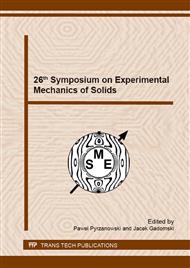[1]
Kocańda S., Kocańda A., Low cycle fatigue strength of metals, PWN, Warsaw, 1989. (Niskocyklowa wytrzymałość zmęczeniowa metali, PWN, Warszawa, 1989).
Google Scholar
[2]
Feltner C.E., Morrow J.D., Microplastic strain hysteresis energy as a criterion for fatigue fracture, Journal Basic Engineering ASME, March, 1961, pp.15-22.
DOI: 10.1115/1.3658884
Google Scholar
[3]
Ellyin F., Kujawski D., Plastic strain energy in fatigue failure. Journal Pressure Vessel Technology, Trans. ASME 106, 1984, pp.342-347.
DOI: 10.1115/1.3264362
Google Scholar
[4]
Gołoś K.,. Plastic strain energy under cyclic multiaxial states of stress. Mechanika Teoretyczna i Stosowana 1(26), (1988), pp.171-177.
Google Scholar
[5]
Mroziński S., Topoliński T., New energy model of fatigue damage acaccumulation and its verification for 45-steel. Journal of Theoretical and Applied Mechanics 2(37), 1999, pp.223-239.
Google Scholar
[6]
Gołoś K., Fatigue of steel in terms of energy, Warsow University of Technology scientific work, 1989. (Trwałość zmęczeniowa stali w ujęciu energetycznym. Prace Naukowe Politechniki Warszawskiej, 1989).
Google Scholar
[7]
Gołoś K., Ellyin F., A total strain energy theory for cumulative fatigue damage. Trans. ASME, Journal of Pressure Vessel Technology, 110, 1988, pp.35-41.
DOI: 10.1115/1.3265565
Google Scholar
[8]
Łagoda T., Fatigue life energy models of structural materials under uniaxial and multiaxial random load, Opole University of Technology, Monography 121, 2001. (Energetyczne modele trwałości zmęczeniowej materiałów konstrukcyjnych w warunkach jednoosiowych i wieloosiowych obciążeń losowych. Studia i monografie 121, Wyd. Politechniki Opolskiej, 2001).
Google Scholar
[9]
Smith K.N., Watson P., Topper T.H.,. A stress-strain function for the fatigue of metals. Journal Materials 5, 1970, pp.767-776.
Google Scholar
[10]
Kaleta J., Experimental basis for the formulation of fatigue energy hypotheses. Wroclaw University of Technology , Monography nr 24, (1998).
Google Scholar
[11]
ASTM E606-92: Standard Practice for Strain - Controlled Fatigue Testing.
Google Scholar
[12]
Mroziński S., Piotrowski M., About fatigue tests end criterion in elevated temperatures, Key Engineering Materials Vol. 598 (2014) pp.153-159.
DOI: 10.4028/www.scientific.net/kem.598.153
Google Scholar
[13]
Mroziński S., Golański G. Influence of temperature change on fatigue properties of P91 steel, Materials Research Innovations, Volume 18 Issue S2 (may 2014), pp.504-508.
DOI: 10.1179/1432891714z.000000000546
Google Scholar


